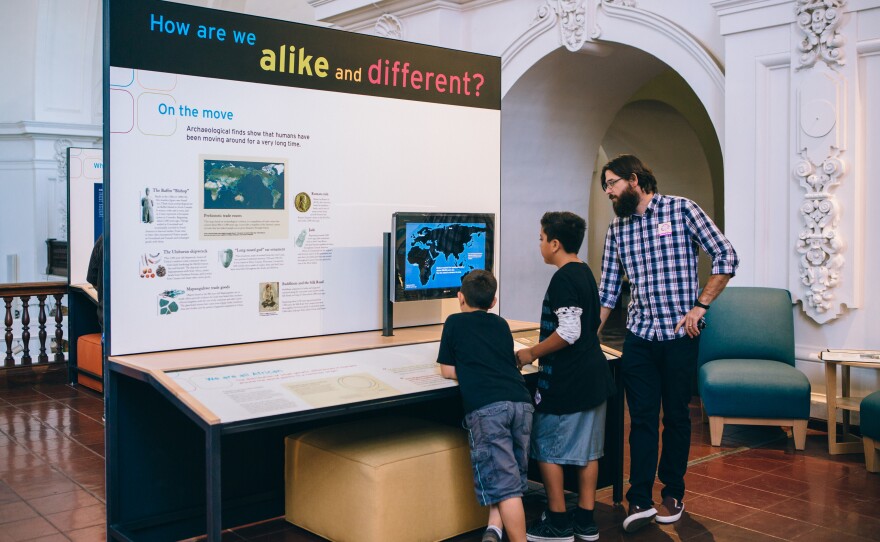The Museum of Man became the Museum of Us in 2020. Now it is reimagining one of its core exhibits, "Race: Are We So Different?"
The goal is to shape the new exhibit through the perspectives of local communities. So the museum is inviting the public to share their thoughts on the current exhibit and to even be paid for their time.
Emerging from the pandemic
The museum has been contemplating changes in a variety of areas for decades but the pandemic prompted some clear action.
"When the pandemic happened, one of our goals as an institution was that we wanted to emerge from the pandemic as a better version of ourselves," said James Haddan, senior director of development and external communications at the Museum of Us. "Our identity should really be matching the work that we're doing."
Community input helped the museum select a new name. Now it wants the public to help reimagining a 2015 exhibit on race.
"The original exhibit was developed by the American Anthropological Association and the Science Museum of Minnesota, and that original exhibit is telling a comprehensive story about race and how are we different," said Exhibit Developer Melinda Barnadas. "So, 2015 feels like a lifetime ago in terms of conversations around race on a local, national, and international level. So now we're giving it an update. And one can build upon the different understandings about how race affects our movement in the world coming from some of these larger conversations that have evolved since 2015."
The museum wants to include the community in those conversations as it considers how to renovate the exhibit. Museums usually turn to scholars, academics and experts in creating exhibits but public input is also key.
"We have not abandoned scholars and experts or the content that's coming from the current exhibit but we are challenging and continuing to challenge the notion of who the expert is," Barnadas said. "We want to include lived experiences and support them with the ideas from scholars, from artists and experts who allow us to see and think about our shared experiences in different ways."
Now through mid-February, public surveys and interviews are being conducted at the museum. People have the option of making an appointment for an in-depth interview about the current exhibit or anonymously doing a five-minute survey on an iPad. In exchange for the hourlong, in-depth interview, the museum will give people $50 and membership for a year to the Museum of Us.
"It's important to extend and engage that conversation in ways that continue to serve to be inclusive, intersectional, and reflective of what people are actually experiencing and understanding about how race affects their lives and those around them," Barnadas said.
Museum history
Living in San Diego, residents may take museums for granted and forget how they started or realize how they are changing.
The Museum of Us was founded in 1915 for the Panama California Exposition as an anthropology museum.
"It really was taking an academic approach at looking at cultures, especially ancient cultures, and really kind of producing exhibits that were three-dimensional ethnographies of those ancient cultures," Haddan said. "So it's a very academic approach to that. And those exhibits were really developed by curators who were not, for example, descendant members of those communities, so white, often male, academically-trained folks who were looking back or at other cultures and producing exhibits and programs around those."

But, the museum officially changed its mission in 2012.
"The mission in 2012 was officially voted on to be inspiring human connections by exploring the human experience," Haddan stated. "And so the way I kind of describe that is, first of all, we really want to look at issues and stories across cultures and time that really impact all of us in our day-to-day lives. And a special kind of focus is that we're really looking at the stories from communities that have been overlooked or silenced in the past."
The race exhibit from 2015 talked about how race is a cultural construct and not biologically based.
"I often talk about how [the exhibit is] really to help people understand that the concept of race is a cultural concept. Biologically, we're all the same," Haddan said. "The gene that creates a skin color change is no bigger than a gene that creates an eye color change, for example."
Now the museum wants to expand on that discussion with community input about how race may affect our everyday lives and how that needs to be reflected in a museum setting. The museum is encouraging people to come and experience the exhibit in its current form and then provide input on what they would like to see change or be added.
The input the museum is seeking will be collected and considered as the exhibit is redesigned. People can make an appointment to be interviewed by emailing museum@museumofus.org.








